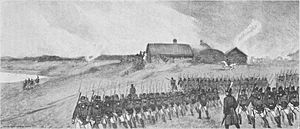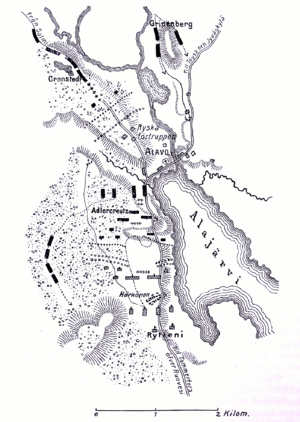Battle of Alavus facts for kids
Quick facts for kids Battle of Alavus |
|||||||
|---|---|---|---|---|---|---|---|
| Part of the Finnish War | |||||||
 Finnarnas framryckning vid Alavo, by Magnus Adlercreutz |
|||||||
|
|||||||
| Belligerents | |||||||
| Commanders and leaders | |||||||
| Strength | |||||||
| 3,850 12 guns |
2,400 8 guns |
||||||
| Casualties and losses | |||||||
| 212 killed, wounded or captured | 367 killed, wounded or captured | ||||||
The Battle of Alavus was an important fight during the Finnish War. It happened on August 17, 1808, near the town of Alavus in Finland. In this battle, the Finnish army, led by General Carl Johan Adlercreutz, won against a smaller Russian army. They pushed the Russians back to the south. This victory was the last big success for the Swedish and Finnish forces in the summer of 1808. It also marked a major turning point in the war.
Why the Battle Happened
Before the battle, the Russian army was having trouble. Their supply lines (the ways they got food and equipment) were being attacked by Swedish forces. This made the Russian general, Nikolay Kamensky, decide to try and take control again.
He had to move his troops to Jämsä because of these problems. By August 7, things started to get better for him. Swedish attacks slowed down, and he began to get more soldiers and supplies. General Kamensky then decided to start attacking again. He sent a group of soldiers, led by Colonel Erikson, towards Alavus.
The Swedish commander, Wilhelm Mauritz Klingspor, heard about the Russian movements. He was likely encouraged by a recent victory at Kauhajoki. So, he ordered General Adlercreutz to attack the Russian soldiers at Alavus. The Swedish and Finnish army was very tired from fighting all summer. They marched south on August 16 in heavy rain. Luckily, the next day, the weather cleared up.
The Battle Begins
On a bright, sunny day, General Adlercreutz's army attacked the Russian positions. The Russians were located south of the Alavus church, near a small village called Härkölä. The Finnish army had good protection. On their left side was Lake Alajärvi (now called Alavudenjärvi or Kirkkojärvi). On their right side, there was marshy (swampy) ground.
The Russian army fought back strongly on their right side. They managed to push one group of Finnish soldiers, called a battalion (a large group of soldiers), back to the north. But General Adlercreutz quickly reacted. He ordered another group of soldiers, the 3rd battalion of the Savolax infantry regiment, to counterattack. They were supported by the 2nd battalion.
After a lot of gunfire, the Finnish soldiers charged forward with their bayonets. A bayonet charge is when soldiers attach knives to the end of their rifles and run at the enemy. This brave charge pushed the Russians back. The Russian soldiers on their left side were also struggling and started to give way. By 7:00 PM, the entire Russian force had retreated. The Russians lost about 370 soldiers, while the Swedish and Finnish side lost around 200.
What Happened Next
Even though the Swedish and Finnish forces won this battle, their commander, Klingspor, didn't use this success to his advantage. He also didn't fully use the victory at Lapua or the problems the Russians had with their supplies.
After the defeat at Alavus, the luck of the war started to change for the Russians. General Kamensky was successful in his own counterattack. This pushed the Swedish and Finnish armies further and further north.


